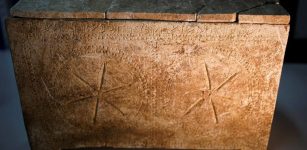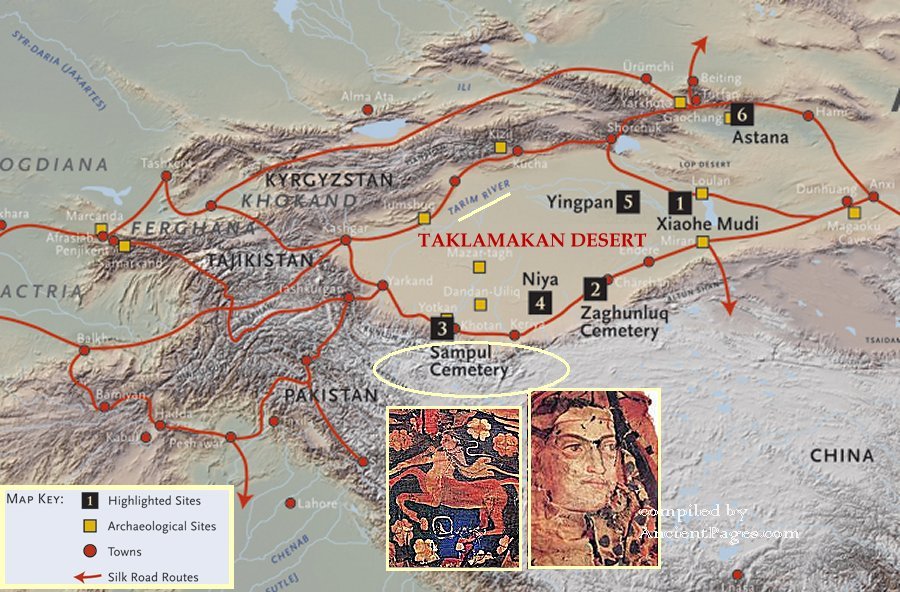Sampul Tapestry: Mysterious Silk Road Textile Linked To Hellenistic Kingdoms Of Central Asia And Tarim Basin
A. Sutherland - AncientPages.com - This tapestry was unearthed during excavations in 1983/84 at an ancient burial site in the Tarim Basin's oasis settlement of Sampul (or Shanpula) in western China.
The Tarim Basin - one of the most remote places on earth - is mostly covered by Taklamakan Desert, a mysterious, huge mass of sand with an area of 337,000 km2 (130,000 sq mi).
In Uigur language, ‘Takla Makan’ means ‘you can get into it but can never get out’ and that is why the desert is also called ‘the Sea of Death’.
Hazardous to cross and at the same time, very significant to the people in the region, the Taklamakan has many traces of the ancient civilizations. Many different people lived and passed through the Tarim Basin, before the Silk Road, and after its height.
This place is known of many archaeological treasures found in the Taklamakan’s sandy and forgotten ruins, especially - Tarim mummies, which date from 1800 BC to the first centuries BC.
See also:
Secret Ancient World Buried Under The Vast Takla Makan Desert
Lost Ancient Greco-Bactrian Kingdom Of 1,000 Cities
The Bayeux Tapestry: One Of The Great Historical Records Of The Middle Ages
Sampul Tapestry – a woolen 'wall hanging is made of 24 threads of various colors, and depicts a warrior and centaur - was discovered in a mass grave of the Sampul Cemetery, located east of the garrison town of Khotan.
Sampul is part of a gigantic concentration of ancient cemeteries extending over an area of 8 square miles.
Among the most important discoveries of this cemetery, there are two large shaft graves with the combined burials of 279 people, along with timber-built graves and boat-shaped coffins. Many bodies buried in the region look more Caucasian than oriental.
Additionally, archaeologists also found a tapestry that dates to the 3rd century BC to the 4th century CE) and is 48 cm wide and 230 cm long.
It depicts a warrior, who is believed to be a Greek soldier and the centaur in the background, is also a motif of Greek art.
The centaur fragment is 45 cm by 55 cm; warrior's face fragment is 48 cm by 52 cm.
The recovered tapestry only constitutes the left part of the decorative border of what would be a much bigger wall hanging.
The tapestry depicts a man with Caucasoid features, including blue eyes, and a centaur.
If lost fabric is accounted for, the soldier would be about six times as tall as the centaur.
The subject is identified as a warrior by the spear he is holding in his hand as well as a dagger tucked on his waist. He wears a tunic with rosette motifs. His headband could be a diadem, a symbol of kingship in the Hellenistic world – and represented on Greek and Macedonian coins. The centaur is playing a horn while wearing a cape and a hood. Surrounding him is a diamond-shaped floral ornament.
Interestingly, archaeologists unearthed the tapestry fashioned into a pair of man's trousers, while all the other trousers discovered in the Sampul cemetery had no decoration.
It is believed that the tapestry probably comes from the Greco-Bactrian Kingdom in Central Asia. The artifact is on permanent display in the Xinjiang Museum, Ürümqi, China.
Written by - A. Sutherland – AncientPages.com
Copyright © AncientPages.com All rights reserved. This material may not be published, broadcast, rewritten or redistributed in whole or part without the express written permission of AncientPages.com
More From Ancient Pages
-
 On This Day In History: Statue Of Venus de Milo Is Discovered On The Aegean Island Of Milos – On Apr 8, 1820
News | Apr 8, 2016
On This Day In History: Statue Of Venus de Milo Is Discovered On The Aegean Island Of Milos – On Apr 8, 1820
News | Apr 8, 2016 -
 Ancient Mesopotamian City Lagash Reveals More Archaeological Secrets
Archaeology | Jan 25, 2023
Ancient Mesopotamian City Lagash Reveals More Archaeological Secrets
Archaeology | Jan 25, 2023 -
 Catacombs Of Kom El Shoqafa – Largest Roman Burial Site In Egypt
Featured Stories | Feb 8, 2021
Catacombs Of Kom El Shoqafa – Largest Roman Burial Site In Egypt
Featured Stories | Feb 8, 2021 -
 Minoans: Highly Advanced Bronze Age Civilization Of Europe
Featured Stories | Sep 23, 2023
Minoans: Highly Advanced Bronze Age Civilization Of Europe
Featured Stories | Sep 23, 2023 -
 Ancient People In Tasmania Witnessed Stunning Auroras When The Earth’s Magnetic Field Flipped
News | Feb 19, 2021
Ancient People In Tasmania Witnessed Stunning Auroras When The Earth’s Magnetic Field Flipped
News | Feb 19, 2021 -
 Why Is La Ferrassie Man A Unique And Famous Neanderthal?
Featured Stories | Oct 30, 2023
Why Is La Ferrassie Man A Unique And Famous Neanderthal?
Featured Stories | Oct 30, 2023 -
 Neanderthals May Have Been Carnivores – New Study
Archaeology | Oct 17, 2022
Neanderthals May Have Been Carnivores – New Study
Archaeology | Oct 17, 2022 -
 Unique Hoard Of Roman-British Coins Found Near Utrecht, The Netherlands
Archaeology | Jan 27, 2025
Unique Hoard Of Roman-British Coins Found Near Utrecht, The Netherlands
Archaeology | Jan 27, 2025 -
 Are Climate-Related Calamities Erasing Illinois’ Cultural History? An Archaeologist Explains
Earth Changes | Dec 27, 2024
Are Climate-Related Calamities Erasing Illinois’ Cultural History? An Archaeologist Explains
Earth Changes | Dec 27, 2024 -
 Fragment Of A Fine Marble Statuette Of Heracles Found In Jezreel Valley, Israel
Archaeology | May 24, 2023
Fragment Of A Fine Marble Statuette Of Heracles Found In Jezreel Valley, Israel
Archaeology | May 24, 2023 -
 Sacred And Mysterious Lake Titicaca Still Holds Many Ancient Secrets
Ancient Mysteries | Jul 13, 2017
Sacred And Mysterious Lake Titicaca Still Holds Many Ancient Secrets
Ancient Mysteries | Jul 13, 2017 -
 10 Remarkable Jain Temples – Marvelous Ancient Architecture And Stone Carvings
Featured Stories | Dec 17, 2015
10 Remarkable Jain Temples – Marvelous Ancient Architecture And Stone Carvings
Featured Stories | Dec 17, 2015 -
 World’s Oldest Paycheck Reveals Ancient Sumerian Workers Were Paid In Beer
Ancient History Facts | Nov 22, 2018
World’s Oldest Paycheck Reveals Ancient Sumerian Workers Were Paid In Beer
Ancient History Facts | Nov 22, 2018 -
 ‘Ali Baba Cave’ Treasures: Burial Boxes Inscribed With Jesus’ Name May Help Reconstruct Jesus’ Life And Death
Archaeology | Mar 21, 2017
‘Ali Baba Cave’ Treasures: Burial Boxes Inscribed With Jesus’ Name May Help Reconstruct Jesus’ Life And Death
Archaeology | Mar 21, 2017 -
 Advanced Ancient Civilization’s Encounter With Primitive People Led To Something Extraordinary – Thought-Provoking Theory Suggests
Ancient Mysteries | Dec 19, 2018
Advanced Ancient Civilization’s Encounter With Primitive People Led To Something Extraordinary – Thought-Provoking Theory Suggests
Ancient Mysteries | Dec 19, 2018 -
 Unusual Find – Headless Skeletons Discovered In A 7000-Year-Old Mass Grave In Slovakia
Archaeology | Jan 12, 2023
Unusual Find – Headless Skeletons Discovered In A 7000-Year-Old Mass Grave In Slovakia
Archaeology | Jan 12, 2023 -
 First Complete Roman Funerary Bed Found In Britain
Archaeology | Feb 19, 2024
First Complete Roman Funerary Bed Found In Britain
Archaeology | Feb 19, 2024 -
 Mayan Maize God And Ancient City Of El Mirador
Featured Stories | Apr 25, 2019
Mayan Maize God And Ancient City Of El Mirador
Featured Stories | Apr 25, 2019 -
 10 Ancient Love Symbols
Ancient Symbols | Jan 5, 2016
10 Ancient Love Symbols
Ancient Symbols | Jan 5, 2016 -
 Aristotle’s Influence On Education Of Alexander The Great – Historical Encounter Of Two Famous Men
Featured Stories | Dec 24, 2018
Aristotle’s Influence On Education Of Alexander The Great – Historical Encounter Of Two Famous Men
Featured Stories | Dec 24, 2018



